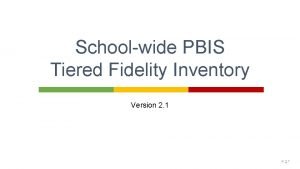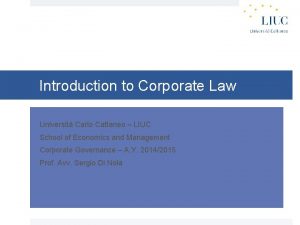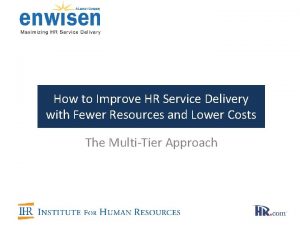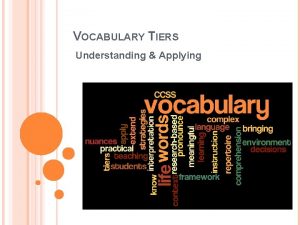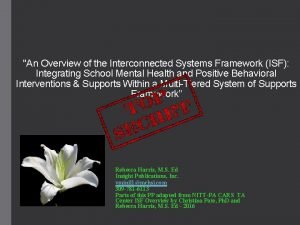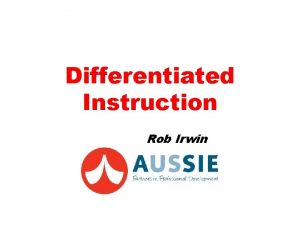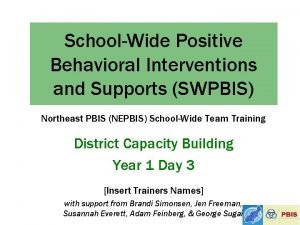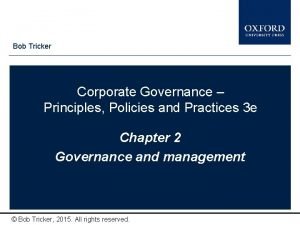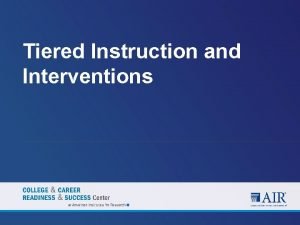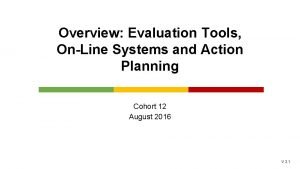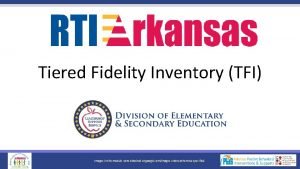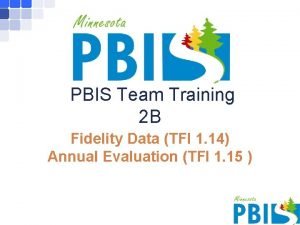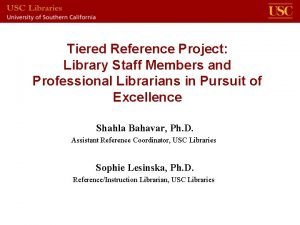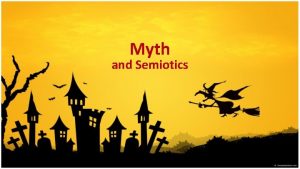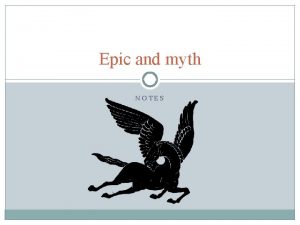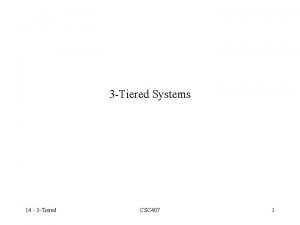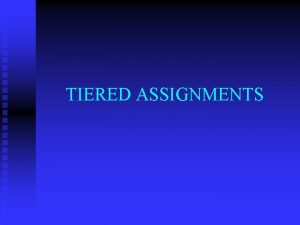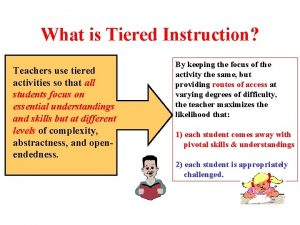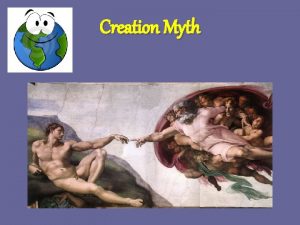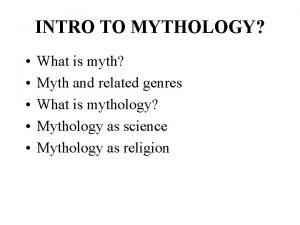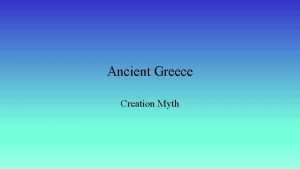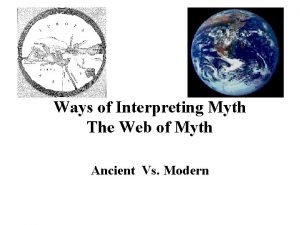Managing the Myth of ShelfReady Creating a Tiered




















- Slides: 20

Managing the Myth of Shelf-Ready: Creating a Tiered Workflow for Bibliographic Records Alayne Mundt Sandler, Metadata Librarian Anne C. Elguindi, Director of Information Delivery Services American University Library

The Landscape �Merging Acquisitions and Cataloging functions and workflows �Continuous development of new technologies, schemas, and materials �Administrative pressures: �Focus on unique content and digital materials �Shelf-ready should go straight to the shelf

Who are we? �American University is an independent coeducational institution with 12, 705 students enrolled in its 57 bachelor’s programs; 52 master’s programs; nine doctoral programs; and a JD program. �The library’s monographic collections include 980, 000 books including 701, 518 print books. �The library subscribes to more than 300 databases, 60, 000 on-line periodicals, and 1, 000 print periodicals. �Regarding shelf-ready services, we have used Blackwell, Coutts, and OCLC services for the past two years.

What is Shelf-Ready? �Two sides – Cataloging and Processing �Cataloging options: �Vendor-supplied records �World. Cataloging Partners (WCP) program �Levels of service: Basic, 100%, Customized �Vendor-enhanced WCP records �Processing options: �Vendor-specific, including spine labels, stamps, bookplates, etc.

Challenges of Shelf-Ready �Issues we have had �Record quality – selection process of WCP �Recent unavailability of TOC enhancement of WCP �Processing quality �System-wide failure of WCP �Higher level of service (100% service) disappointing �Data issues – call numbers for spine labels, for example �The realities of outsourcing – it requires management and quality control

Overview �Physical check of books and Processing �Bibliographic data �Encoding level �Dates �Title/Variant titles �Call numbers �Local cataloging practices and other information �Name adjustments

Three Categories of Books �Books that did not pass the “Copy Cataloging” checklist and need to be routed to Cataloging for additional work. �Books that bypass cataloging but need additional processing, such as new spine labels �Books that bypass cataloging and need no additional processing, which can go straight to Circulation to be shelved

Physical check of books/Processing �Check for spine label/spine label protector �Obvious damage to books �Barcode on book �Bookplate/security strip �Books that are Folio sized, have CD-Roms, multiple volumes sent directly to cataloging for additional work. � 300 field must match preliminary pagination and final page number �Double check that 852 matches spine label. �Instructions for adding holdings/item record

Encoding Level �Book is sent to Cataloging if record is not �Full level (_) �Full level input by OCLC participants (I) �Core level (4)

Check publication date �Check publication or copyright date on T. P. verso against three places in cataloging record: � 008 �Date in 050 and/or 090 � 260 $c �If date on book doesn’t match in all three places, Receiving Specialist routes book to Cataloging

�Checklist contains screenshots of the date in the 008, T. P. verso as examples of where to look.

050/090 �If both present, check to see if they are identical. If not, send to Cataloging. �Call number on spine must match call number in holdings exactly. �Recent challenges– Spine label not always generated from holdings

245 (Title) �Names in 245 $c must match names in 7 xx exactly. �Title on title page must match 245 $a exactly. �Variant spellings �Numbers �Abbreviations �Symbols such as $ or &, and other symbols that do not need spelled out versions such as exclamation points– checklist addresses differences in all of these !, @, #, $, %, &, + �If these alternate titles are already in record, no need to route to Cataloging.

Standard Numbers, 260, 6 xx � 020 (last four digits) � 035 must be preceded by prefix “OCo. LC” � 260: Name should match title page. Does not need to match exactly (e. g. Pub. vs. Publisher). �Books missing 6 xx fields are forwarded to Cataloging.

Local Practices �National Literatures �Historical local practice to reclassify some national literatures. Any book in certain call number ranges is forwarded to Cataloging. �Books lacking 505’s (TOC information) �Books with editor(s) and no 505 field are forwarded to Cataloging (we add this manually).

Name Adjustments �Check to see if name in 245 matches name in 100 or 700 field. �Books with 720 are forwarded to Cataloging. �Check to see if name in 245 can “lay on top of” name in 100 or 700 and fit within it without any variations, e. g. : �Can bypass Cataloging 100: Pogge, Thomas Winfried Menko 245: Pogge, Thomas W.

�Forwarded to Cataloging for authority work 100: Pogge, Thomas Winfried Menko 245: Pogge, A. Thomas 245: Pogge, Thomas W. M. 245: Pogge, Tom *(but not Pogge, Thom)

Benefits �Expands boundaries of cataloging knowledge �Can show new personnel the ‘why’ behind good quality control, and they can see their work as valuable �Almost anyone can do this – it’s a checklist �Opens up time for cataloging unit �This project cut down the number of books that require an in-depth review by trained Cataloging Specialists by 45% �Speeds up time to the shelf �This project took two weeks off of the time between these books coming in the door and going on the shelf

Conclusions �Talk with your administrators about the need for good cataloging – show them concrete examples in your catalog and discovery layers. �This is our version of “good enough. ” �This allows you to take an active and leading role, presenting administrators with something they want but in a way you are comfortable doing it.

Thank you! �Any questions? �You can also contact us at mundt@american. edu or elguindi@american. edu.
 Tiered fidelity inventory
Tiered fidelity inventory Eps tiered seating
Eps tiered seating Two tiered board structure
Two tiered board structure Tier 3 words
Tier 3 words Transforming hr service delivery at kellogg
Transforming hr service delivery at kellogg Tiered task bias task
Tiered task bias task Dynamics 365 tiered pricing
Dynamics 365 tiered pricing Pin name
Pin name Two tiered board structure
Two tiered board structure Tier 1, 2 3 words examples
Tier 1, 2 3 words examples Tiered words
Tiered words Multi tiered system of supports
Multi tiered system of supports Tiered assignments examples
Tiered assignments examples Swpbis tiered fidelity inventory
Swpbis tiered fidelity inventory Tricker
Tricker Tiering assignments
Tiering assignments Tiered accountability
Tiered accountability Swpbis tiered fidelity inventory
Swpbis tiered fidelity inventory Tiered fidelity inventory pbis
Tiered fidelity inventory pbis Bfidelity
Bfidelity Tiered reference service
Tiered reference service
